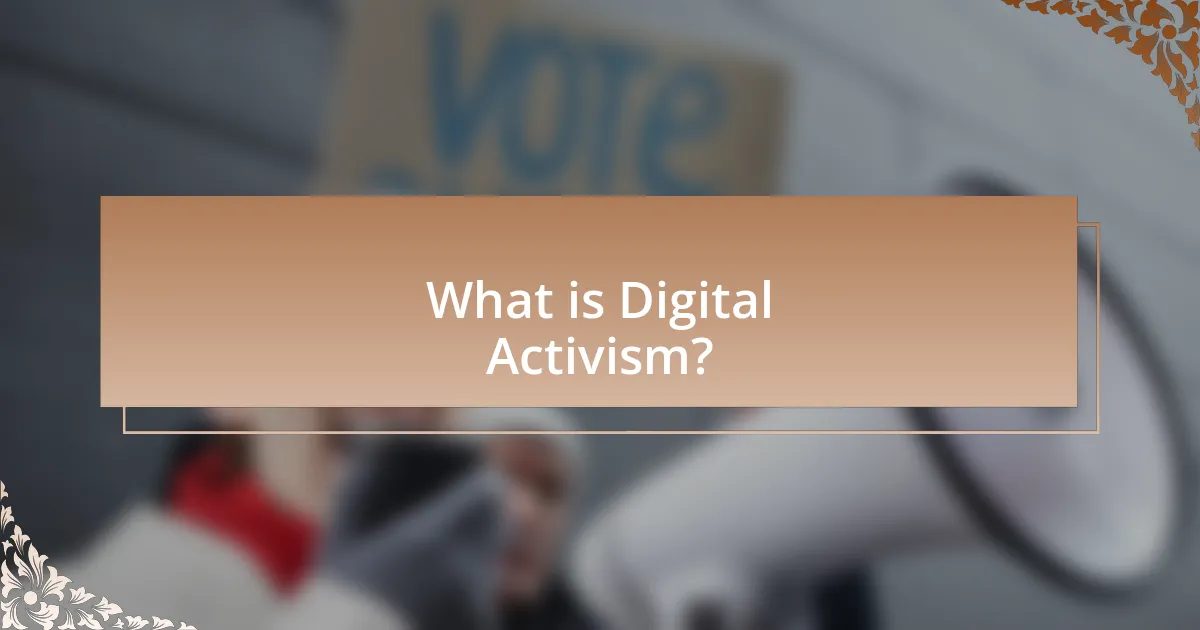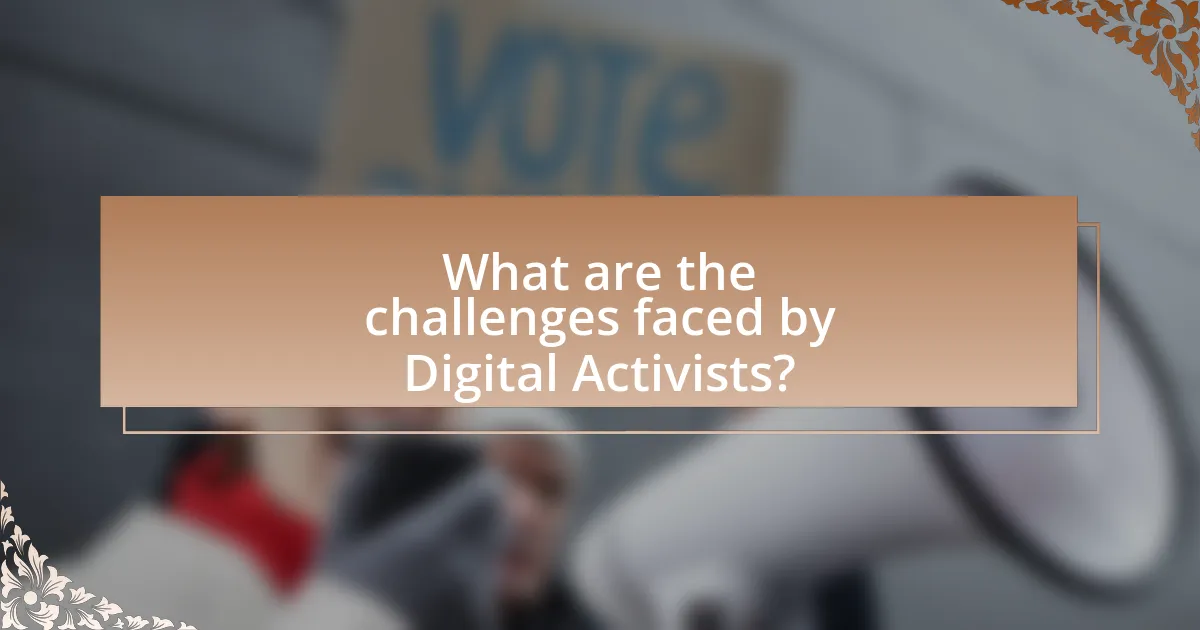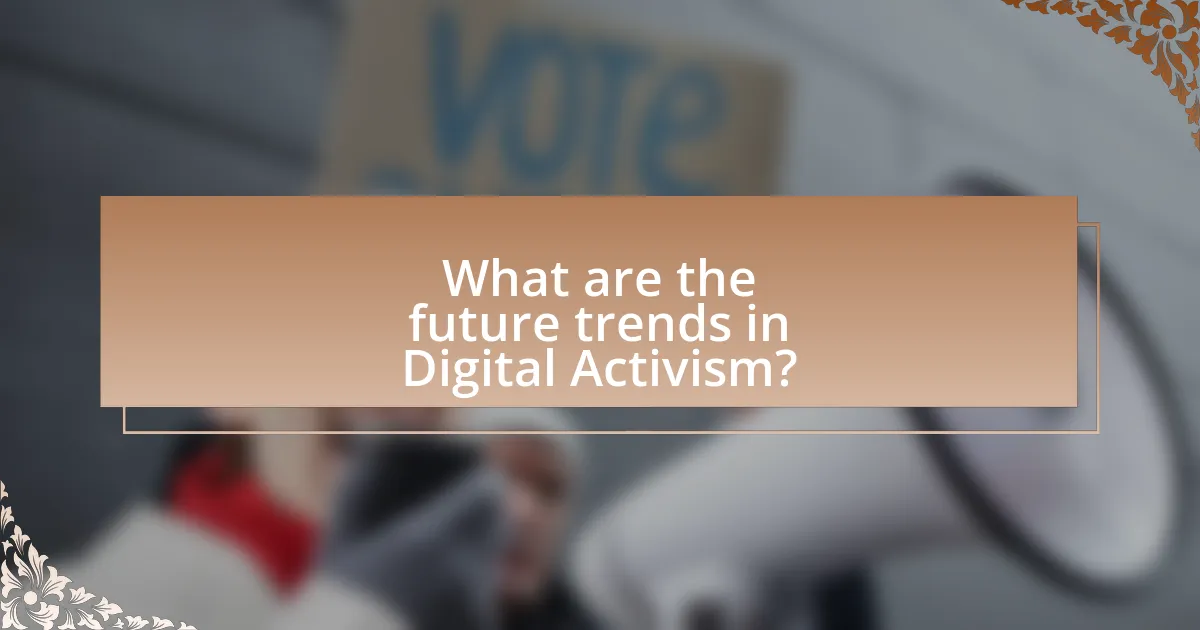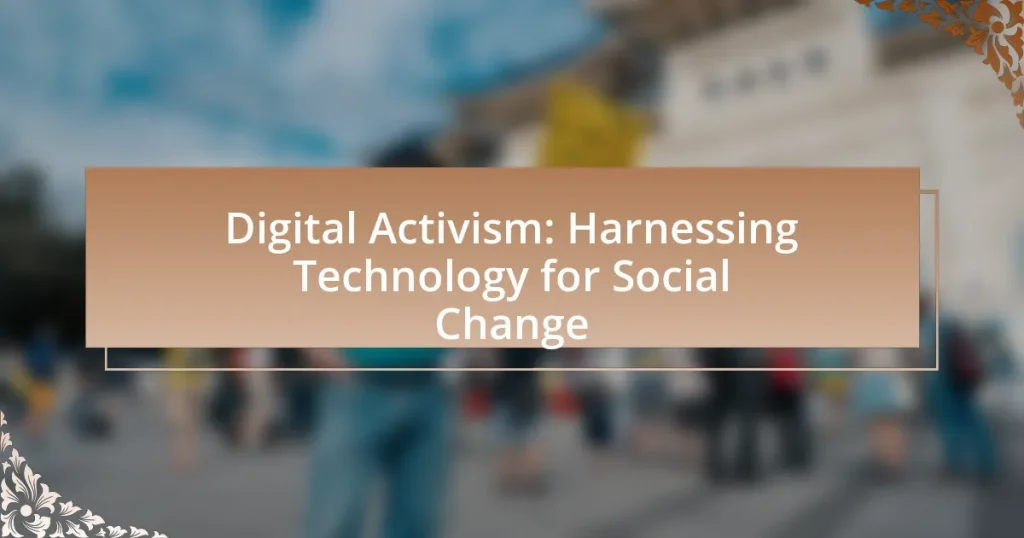Digital activism refers to the use of digital tools and platforms to advocate for social, political, or environmental change, leveraging social media and online campaigns to mobilize support and raise awareness. This article explores the distinctions between digital and traditional activism, highlighting key characteristics such as accessibility, speed, and interactivity. It examines the role of technology in facilitating activism, the challenges faced by digital activists, and strategies to overcome obstacles like misinformation and digital surveillance. Additionally, the article discusses future trends in digital activism, including the impact of emerging technologies and global events on activist strategies, while emphasizing best practices and ethical considerations for effective engagement.

What is Digital Activism?
Digital activism is the use of digital tools and platforms to promote social, political, or environmental change. This form of activism leverages social media, websites, and online campaigns to mobilize support, raise awareness, and influence public opinion. For instance, movements like #BlackLivesMatter and #MeToo have effectively utilized digital activism to galvanize global audiences and drive significant social discourse. The rise of internet access and mobile technology has enabled activists to reach wider audiences quickly, making digital activism a powerful force in contemporary social movements.
How does Digital Activism differ from traditional activism?
Digital activism differs from traditional activism primarily in its use of technology and online platforms to mobilize support and raise awareness. While traditional activism often relies on physical gatherings, printed materials, and face-to-face interactions, digital activism leverages social media, websites, and online campaigns to reach a broader audience quickly and efficiently. For instance, the Ice Bucket Challenge in 2014 raised over $115 million for ALS research through viral social media engagement, showcasing how digital platforms can amplify fundraising efforts and awareness campaigns in ways that traditional methods may not achieve as rapidly.
What are the key characteristics of Digital Activism?
Digital activism is characterized by its use of digital tools and platforms to promote social change and mobilize communities. Key characteristics include accessibility, as it allows individuals from diverse backgrounds to participate in activism regardless of geographical limitations; speed, enabling rapid dissemination of information and mobilization of support; and interactivity, fostering engagement through social media and online campaigns. Additionally, digital activism often employs multimedia content, such as videos and infographics, to enhance message impact and reach wider audiences. These characteristics are evident in movements like the Arab Spring, where social media played a crucial role in organizing protests and sharing information globally.
Why is Digital Activism becoming more prevalent?
Digital activism is becoming more prevalent due to the widespread accessibility of the internet and social media platforms, which facilitate rapid communication and mobilization. The rise of smartphones and affordable internet access has empowered individuals to engage in activism from anywhere, allowing for real-time sharing of information and experiences. According to a 2021 Pew Research Center study, 53% of Americans reported using social media to express their political views, highlighting the significant role these platforms play in modern activism. Additionally, digital tools enable grassroots movements to gain visibility and support quickly, as seen in movements like #BlackLivesMatter and #MeToo, which have effectively utilized online platforms to raise awareness and drive social change.
What role does technology play in Digital Activism?
Technology serves as a crucial enabler in digital activism by facilitating communication, mobilization, and awareness-raising among activists and the public. It allows for the rapid dissemination of information through social media platforms, enabling movements to reach a global audience instantly. For instance, the Arab Spring in 2010 showcased how platforms like Twitter and Facebook were instrumental in organizing protests and sharing real-time updates, leading to significant political changes in several countries. Furthermore, technology provides tools for data collection and analysis, empowering activists to substantiate their claims and strategies with concrete evidence, thereby enhancing their effectiveness in advocating for social change.
How do social media platforms facilitate Digital Activism?
Social media platforms facilitate digital activism by providing a space for rapid information dissemination and community mobilization. These platforms enable activists to share messages, organize events, and raise awareness on social issues quickly, reaching a global audience. For instance, the #BlackLivesMatter movement gained significant traction through Twitter and Instagram, where users shared personal stories, videos, and calls to action, leading to widespread protests and policy discussions. Additionally, social media algorithms can amplify messages, allowing them to go viral, which further enhances visibility and engagement. According to a study by the Pew Research Center, 69% of adults in the U.S. use social media, making it a powerful tool for grassroots movements to connect with supporters and influence public opinion.
What technologies are commonly used in Digital Activism?
Digital activism commonly utilizes social media platforms, websites, mobile applications, and data visualization tools. Social media platforms like Twitter and Facebook enable rapid information dissemination and community mobilization, evidenced by movements such as the Arab Spring, where social media played a crucial role in organizing protests. Websites serve as hubs for information sharing and fundraising, while mobile applications facilitate grassroots organizing and communication. Data visualization tools help activists present complex information in an accessible format, enhancing public understanding and engagement. These technologies collectively empower individuals and groups to advocate for social change effectively.
What are the main goals of Digital Activism?
The main goals of digital activism are to raise awareness, mobilize support, and drive social change through online platforms. Digital activism aims to inform the public about social issues, often utilizing social media to disseminate information rapidly and widely. For instance, campaigns like #BlackLivesMatter have successfully raised awareness about racial injustice, leading to significant public discourse and policy discussions. Additionally, digital activism seeks to organize grassroots movements, enabling individuals to participate in collective actions such as petitions or protests, exemplified by the global response to climate change through initiatives like Fridays for Future. These goals are supported by the increasing accessibility of technology, allowing diverse voices to contribute to social movements and influence policy decisions.
How do Digital Activists measure success?
Digital activists measure success through various metrics, including engagement rates, campaign reach, and tangible outcomes such as policy changes or increased awareness. Engagement rates, such as likes, shares, and comments on social media platforms, provide immediate feedback on the resonance of their messages. Campaign reach, which can be quantified by the number of people exposed to their content, indicates the breadth of their influence. Additionally, successful digital activism is often assessed by the achievement of specific goals, such as the implementation of new policies or the mobilization of community actions, which can be tracked through reports and studies that document these changes. For instance, a study by the Pew Research Center highlights that 64% of social media users have engaged in activism online, demonstrating the effectiveness of digital platforms in driving social change.
What social issues are most commonly addressed through Digital Activism?
Digital activism commonly addresses social issues such as climate change, racial equality, gender rights, LGBTQ+ rights, and poverty alleviation. These issues are prevalent in various online campaigns and movements, leveraging social media platforms to raise awareness and mobilize support. For instance, the #BlackLivesMatter movement has effectively utilized digital activism to highlight racial injustice and police brutality, leading to widespread protests and policy discussions. Similarly, campaigns like #MeToo have brought attention to sexual harassment and gender inequality, resulting in significant societal shifts and legislative changes.

What are the challenges faced by Digital Activists?
Digital activists face several challenges, including censorship, digital surveillance, and the spread of misinformation. Censorship can limit their ability to communicate and organize, as governments and corporations may block access to certain platforms or content. Digital surveillance poses a risk to their privacy and safety, as activists may be monitored by authorities, leading to potential repercussions. Additionally, the proliferation of misinformation complicates their efforts to raise awareness and mobilize support, as false narratives can undermine their messages and objectives. These challenges are well-documented, with reports indicating that over 60% of activists have experienced some form of online harassment or censorship, highlighting the significant obstacles they encounter in their work.
What obstacles do Digital Activists encounter online?
Digital activists encounter several obstacles online, including censorship, misinformation, and digital surveillance. Censorship can manifest through government restrictions on internet access or the removal of content deemed inappropriate, limiting activists’ ability to communicate and organize. Misinformation complicates the digital landscape, as false narratives can undermine legitimate movements and confuse public perception. Digital surveillance poses a significant threat, as activists may be monitored by authorities, leading to potential harassment or arrest. According to a report by Freedom House, 70 countries experienced a decline in internet freedom in 2021, highlighting the pervasive challenges faced by digital activists globally.
How does misinformation impact Digital Activism?
Misinformation significantly undermines digital activism by distorting public perception and eroding trust in legitimate movements. When false information spreads, it can lead to confusion among supporters, diverting attention from critical issues and diluting the effectiveness of campaigns. For instance, a study by the Pew Research Center found that 64% of Americans believe misinformation has caused confusion about basic facts, which can hinder collective action and mobilization efforts. Furthermore, misinformation can create polarization, causing divisions within activist communities and making it challenging to present a united front. This fragmentation ultimately weakens the overall impact of digital activism initiatives aimed at fostering social change.
What are the risks of digital surveillance for activists?
Digital surveillance poses significant risks for activists, primarily by compromising their privacy and safety. Surveillance can lead to the identification of activists, making them vulnerable to harassment, arrest, or violence from authorities or opposing groups. For instance, in countries with authoritarian regimes, activists have faced imprisonment after being tracked through their online activities. Additionally, digital surveillance can deter individuals from participating in protests or expressing dissenting opinions due to fear of repercussions, thereby stifling free speech and limiting collective action. Reports from organizations like Amnesty International highlight cases where surveillance technologies have been used to target human rights defenders, illustrating the real-world implications of these risks.
How can Digital Activists overcome these challenges?
Digital activists can overcome challenges by employing strategic communication, leveraging technology, and building coalitions. Strategic communication involves crafting clear, compelling messages that resonate with diverse audiences, which can enhance engagement and mobilization. Leveraging technology includes utilizing secure platforms for organizing and disseminating information, thereby protecting activists from surveillance and censorship. Building coalitions with other organizations and communities can amplify voices and resources, creating a stronger collective impact. For instance, the Arab Spring demonstrated how digital activists effectively used social media to coordinate protests and share information, leading to significant political change.
What strategies can be employed to combat misinformation?
To combat misinformation, strategies such as fact-checking, media literacy education, and the use of technology to identify false information can be employed. Fact-checking organizations, like Snopes and FactCheck.org, verify claims and provide accurate information, helping to counter false narratives. Media literacy education equips individuals with the skills to critically evaluate sources and discern credible information from misinformation. Additionally, technology platforms can implement algorithms and AI tools to detect and flag misleading content, as seen in initiatives by Facebook and Twitter to reduce the spread of false information. These strategies collectively enhance public awareness and promote informed decision-making.
How can activists protect their privacy online?
Activists can protect their privacy online by using encrypted communication tools, such as Signal or WhatsApp, which secure messages from unauthorized access. These tools employ end-to-end encryption, ensuring that only the intended recipients can read the messages, thus safeguarding sensitive information. Additionally, activists should utilize Virtual Private Networks (VPNs) to mask their IP addresses and encrypt their internet traffic, making it difficult for third parties to track their online activities. Research indicates that using a VPN can significantly enhance online anonymity, as it reroutes internet connections through secure servers. Furthermore, activists should be cautious about sharing personal information on social media platforms and consider using pseudonyms to maintain anonymity. Implementing these strategies can effectively reduce the risk of surveillance and data breaches, allowing activists to operate more securely in the digital space.

What are the future trends in Digital Activism?
Future trends in digital activism include the increased use of artificial intelligence and machine learning to analyze social issues and mobilize support. These technologies enable activists to identify patterns in data, predict outcomes, and tailor campaigns to specific audiences, enhancing engagement and effectiveness. Additionally, the rise of decentralized platforms, such as blockchain technology, is expected to empower activists by providing secure and transparent ways to organize and fund movements. Furthermore, the integration of augmented reality (AR) and virtual reality (VR) in campaigns will likely create immersive experiences that raise awareness and foster empathy among users. According to a report by the Pew Research Center, 69% of Americans believe social media is an effective tool for activism, indicating a growing reliance on digital platforms for social change.
How is the landscape of Digital Activism evolving?
The landscape of digital activism is evolving through increased use of social media platforms, enhanced accessibility of technology, and the rise of decentralized movements. Social media platforms like Twitter and Instagram have become primary tools for activists to mobilize support, share information, and raise awareness, evidenced by movements such as Black Lives Matter, which gained global traction through viral hashtags and online campaigns. Additionally, the proliferation of smartphones and internet access has empowered more individuals to participate in activism, allowing grassroots movements to flourish in regions previously limited by technological barriers. Furthermore, the emergence of decentralized technologies, such as blockchain, is enabling activists to organize and fund initiatives without centralized control, enhancing transparency and security in fundraising efforts. These trends indicate a shift towards more inclusive, immediate, and innovative forms of activism that leverage technology for social change.
What emerging technologies could influence future activism?
Emerging technologies that could influence future activism include artificial intelligence, blockchain, and augmented reality. Artificial intelligence can analyze vast amounts of data to identify social issues and mobilize support quickly, as seen in campaigns that utilize AI-driven analytics for targeted outreach. Blockchain technology enhances transparency and trust in fundraising and voting processes, which is crucial for grassroots movements, evidenced by its use in secure donation platforms. Augmented reality can create immersive experiences that raise awareness and empathy for social causes, demonstrated by projects that allow users to visualize the impact of climate change in their communities. These technologies collectively empower activists by improving communication, enhancing transparency, and fostering engagement.
How might global events shape the future of Digital Activism?
Global events significantly influence the future of digital activism by altering public awareness, mobilizing communities, and shaping online discourse. For instance, the COVID-19 pandemic accelerated the use of digital platforms for activism, as seen in the surge of online protests and campaigns advocating for social justice, such as Black Lives Matter, which gained unprecedented global traction in 2020. Additionally, geopolitical events, like the Russian invasion of Ukraine, have prompted widespread digital solidarity movements, showcasing how crises can galvanize international support and amplify activist messages across social media. These events demonstrate that as global circumstances evolve, so too will the strategies and effectiveness of digital activism, making it a dynamic force for social change.
What best practices should Digital Activists follow?
Digital activists should prioritize transparency, security, and community engagement. Transparency builds trust and credibility, which are essential for mobilizing support; for instance, organizations like Amnesty International emphasize the importance of clear communication about goals and methods. Security is crucial to protect sensitive information and activists themselves, as evidenced by the rise in cyberattacks against social movements. Utilizing tools like encrypted messaging apps can safeguard communications. Community engagement fosters inclusivity and amplifies diverse voices, as seen in successful campaigns that involve grassroots participation, such as the Black Lives Matter movement. These best practices enhance the effectiveness and sustainability of digital activism.
How can activists effectively engage their audience online?
Activists can effectively engage their audience online by utilizing targeted social media campaigns that resonate with their audience’s values and interests. Research indicates that 69% of adults in the U.S. use social media, making it a powerful platform for outreach and engagement. By creating compelling content, such as videos, infographics, and interactive posts, activists can capture attention and encourage sharing, which amplifies their message. Additionally, leveraging data analytics allows activists to understand audience behavior and preferences, enabling them to tailor their strategies for maximum impact. Engaging in two-way communication, such as responding to comments and facilitating discussions, fosters a sense of community and encourages deeper involvement in the cause.
What ethical considerations should Digital Activists keep in mind?
Digital activists should prioritize the principles of transparency, accountability, and respect for privacy. Transparency involves openly sharing the goals, methods, and funding sources of their campaigns to build trust with their audience and stakeholders. Accountability requires activists to take responsibility for their actions and the consequences of their campaigns, ensuring that they do not inadvertently harm the communities they aim to support. Respect for privacy is crucial, as activists must safeguard the personal information of individuals involved in their initiatives, particularly in sensitive contexts where data breaches could lead to real-world harm. These ethical considerations are essential for maintaining credibility and fostering a positive impact in the realm of digital activism.










